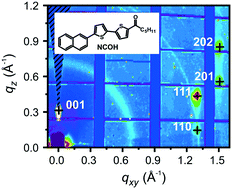Novel highly substituted thiophene-based n-type organic semiconductor: structural study, optical anisotropy and molecular control†
Abstract
Oligothiophenes and their functionalized derivatives have been shown to be a viable option for high-performance organic electronic devices. The functionalization of oligothiophene-based materials allows further tailoring of their properties for specific applications. We have synthesized a new thiophene-based molecule 1-[5′-(2-naphthyl)-2,2′-bithiophen-5-yl]hexan-1-one (NCOH), and we have studied the optical and structural properties of NCOH thin films. NCOH is a highly substituted member of the oligothiophene family, designed to improve its molecular stacking, where the presence of an electron-withdrawing group enhances its electron transport capabilities. Employing in situ and time-resolved grazing-incidence wide-angle X-ray scattering (GIWAXS) measurements, we determined the NCOH thin film crystallographic structure and its evolution starting from the early stages of the film growth. We observed strong optical anisotropy resulting from a highly oriented crystallographic structure. Additionally, we investigated the substrate-induced changes of the molecular orientation utilizing the few-layer MoS2 with different orientations of the atomic layers. This study, with its primary focus on the fundamentally important n-type molecular semiconductor, contributes to the field of organic-based (opto-)electronics.



 Please wait while we load your content...
Please wait while we load your content...